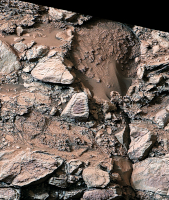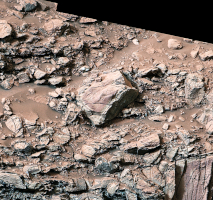
Figure A

Figure B

Figure C
Click on images for larger versionsWhile exploring Gediz Vallis channel, NASA's Curiosity Mars rover came across rocks that show a pale color near their edges. These rings of color changes, also called halos, resemble markings seen on Earth when groundwater leaks into rocks along fractures, causing chemical reactions that change the color. The markings were revealed over eons, after wind and sand eroded the debris pile.
This panorama – captured by Curiosity's Mast Camera, or Mastcam, on May 7, 2024, the 4,178th Martian day, or sol, of the mission – is made up of 40 individual images that were stitched together after being sent back to Earth. The color has been adjusted to match lighting conditions as the human eye would see them on Earth.
Figure A is a crop of the same image with two examples of halos circled.
Figure B is a close-up of the rock halo example on the left.
Figure C is a close-up of the rock halo example on the right.
Curiosity was built by NASA's Jet Propulsion Laboratory, which is managed by Caltech in Pasadena, California. JPL leads the mission on behalf of NASA's Science Mission Directorate in Washington. Malin Space Science Systems in San Diego built and operates Mastcam.
For more about Curiosity, visit: https://science.nasa.gov/mission/msl-curiosity.

